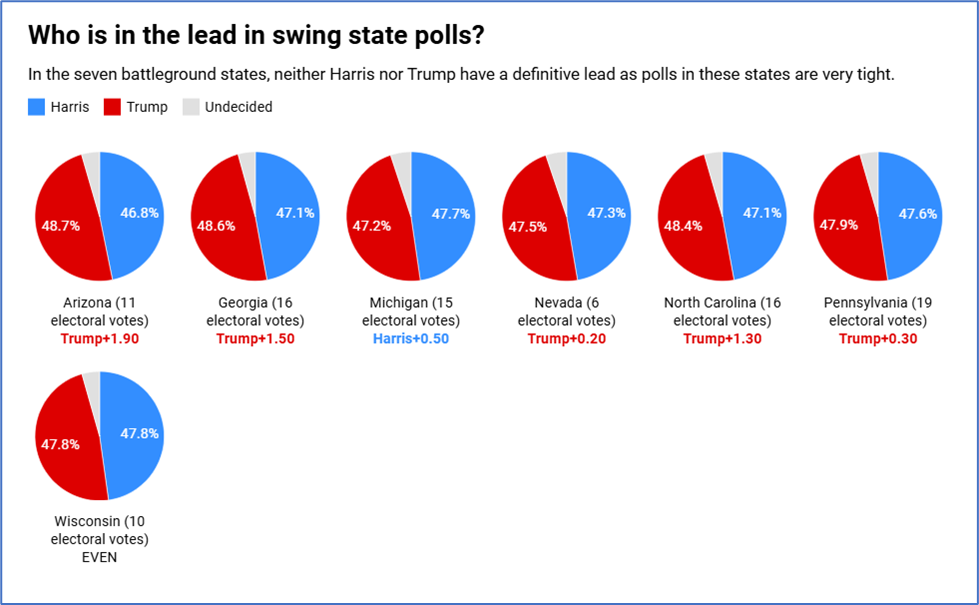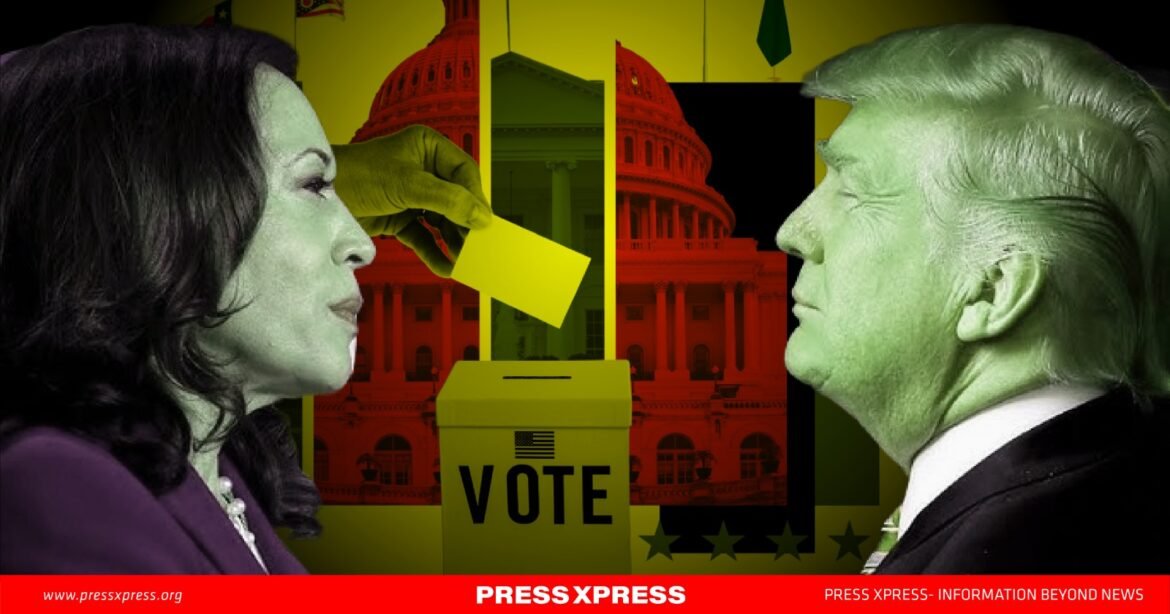With only six days left in the 2024 U.S. presidential race, Kamala Harris and Donald Trump are both pushing hard for votes in crucial battleground states. National polls show Harris with a slight edge, holding around a 1.4 percentage point lead over Trump. However, in a race likely to be decided by slim margins, recent developments on the campaign trail reveal how each candidate is tailoring their strategies to appeal to undecided voters.
Seven key swing states—Pennsylvania, North Carolina, Georgia, Michigan, Arizona, Wisconsin, and Nevada—have become the focus of both campaigns. This final sprint to Election Day reflects a political climate marked by polarizing rhetoric, targeted demographic appeals, and a resurgence of voter activism on issues from labor rights to foreign policy. The stage is set for a historic finish, and both campaigns know that the outcome could hinge on these final moves in a handful of closely contested states.

Harris’ Campaign Focus
Kamala Harris has concentrated much of her recent campaigning efforts in Michigan, a swing state that has historically played a decisive role. Youth turnout in Michigan reached record levels in 2022, and the Harris campaign is tapping into that energy by holding events at university campuses and organizing concerts aimed at younger voters. The Democratic campaign is also working to address criticism from pro-Palestinian groups, who confronted Harris during a rally, expressing discontent with the U.S. stance on the Israel-Gaza conflict. In response, Harris acknowledged the sentiment, assuring voters of her commitment to diplomatic resolution, but the incident underscores her challenge in balancing progressive and moderate Democratic views.
Harris is also focusing on labor issues, a move meant to appeal to Michigan’s working-class voters, many of whom are involved in the state’s automotive and manufacturing sectors. By emphasizing factory job creation and support for labor unions, Harris aims to counteract Trump’s appeal among blue-collar voters in the Midwest. The Democratic campaign’s message is clear: Harris represents a break from the divisive politics they attribute to Trump, emphasizing unity and job growth as key themes. With Michigan’s razor-thin polling margins, this approach could prove pivotal if it manages to energize both young voters and union members.
Trump’s Strategy
Donald Trump’s strategy revolves around securing strong support from conservative and evangelical voters, particularly in Georgia, a state that narrowly shifted Democratic in 2020. During his recent stops in Atlanta, Trump sought to solidify his base by addressing conservative family values and dismissing accusations from opponents labeling him as authoritarian. By framing these criticisms as attacks on his supporters’ values, Trump effectively mobilizes his base, presenting himself as a defender of their interests against what he calls the “establishment media.”
Additionally, Trump has tapped into discontent among Pennsylvania’s working-class voters, where his campaign holds a narrow lead in the polls. Pennsylvania is home to a significant Puerto Rican community, which could prove crucial in such a close race. However, Trump has faced backlash after a speaker at one of his rallies referred to Puerto Rico disparagingly. The former president’s refusal to address this incident directly risks alienating Latino voters in Pennsylvania, a state that offers 19 Electoral College votes and could determine the election’s outcome. Analysts suggest that Trump’s strength in Pennsylvania lies in his economic messaging and appeal to rural voters, but missteps like this could undermine his efforts in critical demographics.
Polling Trends and the Impact of Last-Minute Campaign Efforts
Current polling data reveals a close race, with Harris maintaining a slight lead in Michigan, while Trump holds slim advantages in states like Arizona and North Carolina. Both candidates are campaigning heavily in these battlegrounds, where even minor shifts in voter turnout could sway the final result. The latest FiveThirtyEight polls indicate that margins in these states are well within statistical error, suggesting that the election remains highly uncertain.
Both campaigns are relying on targeted outreach in the final days to secure undecided voters. Harris’s emphasis on youth mobilization, labor support, and minority outreach reflects an effort to build a broad coalition, whereas Trump is focusing on solidifying his evangelical base and rallying conservative rural voters. This tight polling reinforces the importance of each candidate’s strategy in swing states, where turnout could define the 2024 election.

The Final Stretch
As Harris and Trump enter the last days of the campaign, their approaches reflect starkly different visions for America’s future. Harris’s closing arguments emphasize unity, economic recovery, and a break from divisive politics, while Trump’s campaign appeals to a sense of traditional values and a conservative vision for the country. Both candidates’ final rallies in key swing states demonstrate the stakes of this election, as each camp seeks to secure vital voter blocs.
Pennsylvania, with its large Puerto Rican community and working-class voter base, stands as a potential decider for the entire election. Political analysts argue that whoever wins Pennsylvania will likely secure the presidency, given the state’s strategic weight in the Electoral College. With polls fluctuating by narrow margins, the impact of these final campaign moves cannot be overstated. Whether it is Harris’s efforts to rally young and minority voters or Trump’s focus on evangelical support, both campaigns are pulling out all stops to turn every possible vote in their favor.


